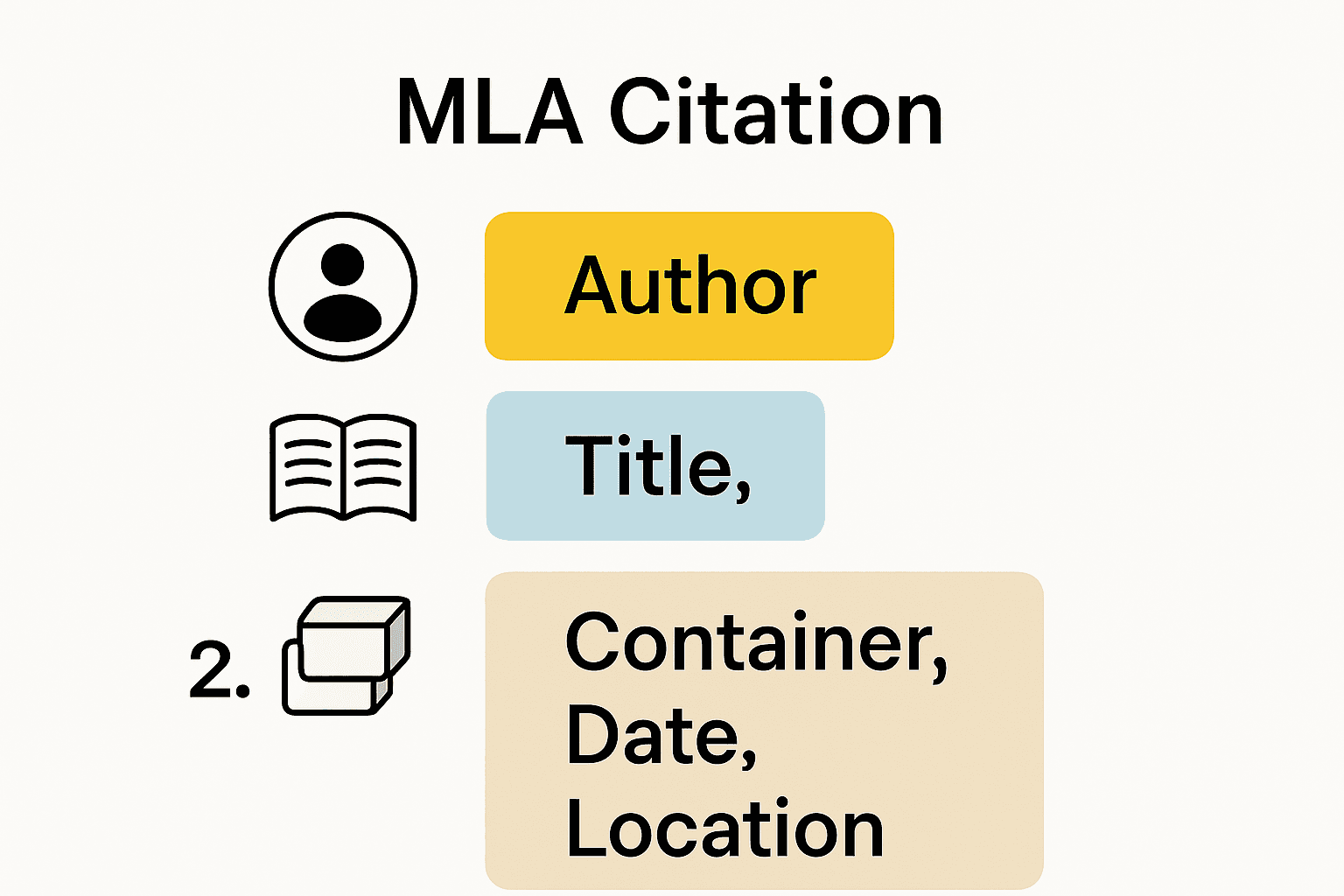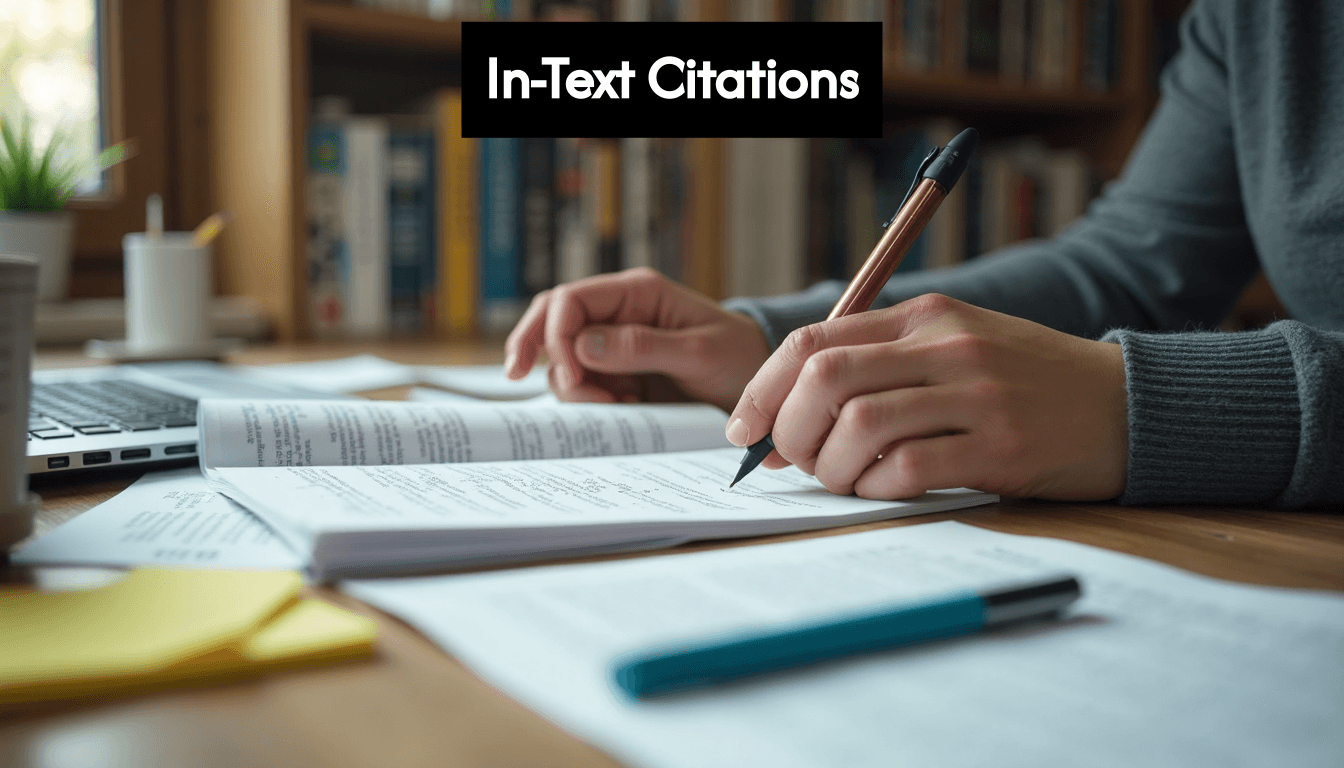Blog
Learning Materials
2025년 MLA 인용에 대한 간단한 가이드 (학생 및 학자를 위한)
Updated: June 10, 2025

MLA 인용은 연구 논문의 성패를 좌우할 수 있습니다. 인용 오류의 약 40%는 출판 날짜나 페이지 번호와 같은 중요한 요소가 누락되어 발생합니다. 이는 MLA가 아무도 신경 쓰지 않을 규칙을 따르는 것이라고 생각하십니까? 사실, 단 하나의 잘못된 쉼표나 누락된 저자와 같은 숨겨진 세부 사항이 순식간에 작업을 약화시킬 수 있습니다. 글이 진지하게 받아들여지길 원한다면, 이러한 인용의 특이점을 이해하는 것이 진정한 열쇠입니다.
목차
요약
| 요점 | 설명 |
|---|---|
| MLA 인용의 핵심 구성 요소 | 주요 인용 요소에는 저자 이름, 출처 제목, 컨테이너 정보, 출판 날짜 및 위치가 포함되며, 이는 정확한 참조에 필수적입니다. |
| 본문 인용 메커니즘 | 본문 인용은 저자의 성과 페이지 번호를 포함해야 하며, 독자가 원본 출처로 쉽게 정보를 추적할 수 있도록 합니다. |
| 참고 문헌 항목 작성 | 참고 문헌 항목은 명확성과 일관성을 유지하기 위해 매달린 들여쓰기, 이중 간격, 알파벳 순서와 같은 특정 구조적 지침을 따라야 합니다. |
| 피해야 할 일반적인 인용 실수 | 빈번한 오류에는 일관되지 않은 형식화와 불완전한 출처 정보가 포함됩니다. 최신 지침에 따라 인용을 두 번 확인하면 이러한 문제를 크게 줄일 수 있습니다. |
| 적극적인 인용 전략 | 인용 관리 도구를 활용하고, 개인 체크리스트를 만들고, 최신 스타일 가이드를 정기적으로 참조하여 학술 글쓰기의 정확성과 전문성을 향상시킵니다. |
MLA 인용 형식 기본 이해
MLA 인용 형식은 연구자와 학생들이 출처를 적절히 인용하고 지적 무결성을 유지하도록 돕는 중요한 학술 글쓰기 표준을 나타냅니다. 현대 언어 협회(MLA)는 학술 글쓰기 전반에 걸쳐 일관되고 명확한 출처 표기를 보장하기 위해 이 체계적인 문서 참조 접근 방식을 개발했습니다.
MLA 인용의 핵심 구성 요소
MLA 인용을 이해하려면 기본 구조 요소를 숙달해야 합니다. 인용은 일반적으로 독자가 원본 출처를 찾고 확인할 수 있도록 하는 주요 정보를 포함합니다. 핵심 인용 요소는 다음과 같습니다:
- 저자 이름: 성, 이름 또는 이니셜
- 출처 제목: 책의 경우 이탤릭체, 기사의 경우 따옴표
- 컨테이너 정보: 출처가 출판된 세부 정보
- 출판 날짜: 출판 연도
- 위치: 페이지 번호 또는 디지털 식별자

이 요소들의 정확한 배열은 필수적인 출처 세부 정보를 전달하는 표준화된 형식을 만듭니다. 학술 성공을 위한 포괄적인 인용 가이드를 사용하는 연구자는 정확한 참조를 구성하는 방법을 빠르게 배울 수 있습니다.
MLA 스타일의 형식 변형
MLA 인용 형식은 다양한 출처 유형에 적응하여 특정한 미세한 접근 방식을 요구합니다. 책과 학술 저널과 같은 인쇄 출처는 웹사이트, 온라인 기사 또는 멀티미디어 콘텐츠와 같은 디지털 출처와 약간 다른 지침을 따릅니다.
인쇄 출처의 경우 기본 구조는 일관성을 유지합니다: 저자의 성, 이름. 기사 제목. 저널 이름, 권호, 발행일, 페이지 범위. 디지털 출처는 종종 URL 또는 DOI 정보가 필요하여 추가적인 복잡성을 도입합니다.
Purdue University의 학술 인용 자료에 따르면, 최신 MLA 지침은 명확성과 재현성을 강조합니다. 이는 다른 연구자가 잠재적으로 귀하의 정확한 출처를 찾을 수 있도록 충분한 맥락 정보를 제공하는 것을 의미합니다.
학자와 학생은 구두점, 대문자 사용 및 이탤릭체 사용에 특별한 주의를 기울여야 합니다. 잘못된 쉼표나 잘못 형식화된 제목은 인용의 유효성을 손상시킬 수 있습니다. MLA 핸드북은 이러한 복잡한 형식 요구 사항에 대한 철저한 세부 정보를 제공합니다.
효과적인 MLA 인용을 위한 주요 고려 사항은 다음과 같습니다:
- 모든 참조에서 일관된 형식화
- 출처 정보의 정확한 표현
- 구두점 지침에 대한 정확한 준수
- 이탤릭체와 따옴표의 적절한 사용
연구 논문, 논문 또는 학술 기사를 작성하든, MLA 인용 형식을 숙달하는 것은 학문적 엄격함과 지적 기여에 대한 존중을 나타냅니다. 이러한 기본 원칙을 이해함으로써, 가장 높은 학술 표준을 충족하는 전문적으로 문서화된 작업을 생성할 수 있습니다.
본문 인용에 대한 단계별 가이드
본문 인용은 학술 글쓰기의 중요한 요소로, 연구자가 텍스트 내에서 직접 출처를 인정할 수 있도록 합니다. 이러한 간단한 참조는 특정 정보의 출처를 즉시 제공하여 독자가 원본 출처를 빠르고 쉽게 추적할 수 있도록 합니다.

기본 본문 인용 메커니즘
MLA 본문 인용은 간단하지만 정확한 접근 방식을 따릅니다. 주요 목표는 독자가 참고 문헌 목록에서 전체 출처를 찾을 수 있도록 충분한 정보를 제공하는 것입니다. Columbia College의 인용 지침에 따르면, 기본 규칙은 저자의 성과 정보가 나타나는 특정 페이지 번호를 포함하는 것입니다.
본문 인용을 구성하기 위한 핵심 원칙은 다음과 같습니다:
- 단일 저자 출처: 저자의 성과 페이지 번호를 괄호 안에 포함합니다. 예: (Smith 45)
- 다수의 저자: 두 명의 저자의 경우, 두 성을 사용합니다. 세 명 이상의 경우, 첫 번째 저자의 성 뒤에 et al.을 사용합니다.
- 저자가 없는 경우: 출처 제목의 처음 몇 단어를 따옴표나 이탤릭체로 사용합니다.
인용을 글에 통합하기
효과적인 본문 인용은 학술 글쓰기에 원활하게 통합되어야 합니다. 포괄적인 본문 인용 가이드는 적절한 배치와 형식에 대한 자세한 통찰력을 제공합니다.
본문 인용을 통합하는 두 가지 주요 방법이 있습니다:
-
괄호 인용: 관련 문장의 끝에 저자와 페이지 정보를 괄호 안에 완전히 배치합니다. 예: 기후 변화는 계속해서 전 세계 생태계에 영향을 미칩니다 (Rodriguez 123).
-
서술 인용: 문장에 저자의 이름을 통합하고, 페이지 번호를 괄호 안에 넣습니다. 예: Rodriguez는 기후 변화가 전 세계 생태계에 극적으로 영향을 미친다고 주장합니다 (124).
Purdue University의 Writing Lab에 따르면, 독자가 전체 출처를 쉽게 찾을 수 있도록 명확하고 간결한 출처 표기를 제공하는 것이 중요합니다.
본문 인용에 대한 특별 고려사항
특정 시나리오는 특정 인용 접근 방식을 요구합니다. 페이지 번호가 없는 전자 출처, 동일한 저자의 여러 작품, 명확한 저자가 없는 출처는 각각 고유한 처리가 필요합니다.
페이지 번호가 없는 출처의 경우:
- 가능하면 단락 번호를 사용합니다.
- 장 또는 섹션 제목을 사용합니다.
- 대안이 불가능한 경우, 페이지 번호를 생략합니다.
동일한 저자의 여러 작품을 인용할 때는 출처를 구별하기 위해 짧은 제목을 포함합니다. 이는 독자가 정확히 어떤 작품을 참조하고 있는지 이해하는 데 도움이 됩니다.
본문 인용을 숙달하는 것은 학문적 무결성과 학문적 정밀성을 나타냅니다. 이러한 지침을 따르면, 다른 연구자의 지적 기여를 적절히 인정하는 명확하고 신뢰할 수 있는 학술 글쓰기를 작성할 수 있습니다.
참고 문헌 항목 작성 방법
참고 문헌 페이지는 학술 글쓰기에서 사용된 출처의 최종적이고 포괄적인 문서를 나타냅니다. 이 중요한 섹션은 독자가 각 출처를 찾고 확인할 수 있도록 하는 전체 서지 정보를 제공합니다.
참고 문헌 항목의 기본 구조
정확한 참고 문헌 항목을 작성하려면 현대 언어 협회가 설정한 정확한 형식 지침을 이해해야 합니다. Indian River State College의 인용 자료에 따르면, 페이지는 특정 구조적 요구 사항을 따라야 합니다:
- 매달린 들여쓰기 사용
- 모든 항목을 이중 간격으로 설정
- 저자의 성을 기준으로 출처를 알파벳 순서로 정리
- 페이지 제목을 Works Cited (또는 출처가 하나인 경우 Work Cited)로 설정
MLA 인용 형식에 대한 포괄적인 가이드는 각 인용에 나타나야 하는 필수 요소를 분해합니다:
- 저자 이름: 성, 이름
- 출처 제목: 적절한 구두점으로 형식화
- 컨테이너 정보: 출판에 대한 세부 정보
- 출판 날짜: 출판 연도
- 위치: 페이지 번호 또는 디지털 식별자
다양한 유형의 출처 형식화
각 출처 유형은 고유한 인용 접근 방식을 요구합니다. 책, 학술 기사, 웹사이트 및 멀티미디어 출처는 각각 특정 형식 고려 사항이 필요합니다. Purdue University의 Writing Lab에 따르면, 핵심 원칙은 일관성을 유지합니다: 독자가 원본 출처를 찾을 수 있도록 충분한 정보를 제공하는 것입니다.
다양한 출처 인용의 예는 다음과 같습니다:
-
책 인용: 성, 이름. 책 제목. 출판사, 출판 연도. 예: Smith, John. Digital Research Methods. Academic Press, 2022.
-
웹사이트 인용: 저자 성, 이름. 기사 제목. 웹사이트 이름, 출판 날짜, URL. 예: Johnson, Emily. Climate Change Trends. Global Research Network, 15 Jan. 2023, www.globalresearch.net/climate-trends.
-
학술 기사 인용: 성, 이름. 기사 제목. 저널 이름, 권호, 발행일, 페이지 범위. 예: Rodriguez, Maria. Urban Ecosystem Dynamics. Environmental Studies, vol. 45, no. 2, 2022, pp. 112-129.
피해야 할 일반적인 실수
학생들은 참고 문헌 항목을 작성할 때 자주 어려움을 겪습니다. 가장 일반적인 오류는 다음과 같습니다:
- 잘못된 구두점
- 일관되지 않은 형식화
- 중요한 출처 정보 누락
- 잘못된 알파벳 순서
정확성이 중요합니다. 잘못된 쉼표 하나 또는 잘못된 대문자 사용은 인용의 유효성을 손상시킬 수 있습니다. 최신 MLA 지침에 따라 각 항목을 두 번 확인하는 데 시간을 할애하십시오.
참고 문헌 항목을 숙달하는 것은 학문적 엄격함과 지적 정직성을 나타냅니다. 출처를 신중하게 문서화함으로써, 연구의 신뢰성을 뒷받침하는 투명한 연구 경로를 제공합니다. 각 인용은 기술적 요구 사항 그 이상이며, 연구를 뒷받침하는 지적 기여에 대한 학문적 인정입니다.
일반적인 MLA 인용 실수 및 팁
MLA 인용 요구 사항을 탐색하는 것은 학생과 연구자에게 도전이 될 수 있습니다. 일반적인 함정을 이해하고 전략적 접근 방식을 배우면 학술 글쓰기의 정확성과 전문성을 크게 향상시킬 수 있습니다.
피해야 할 기본 인용 오류
MLA 인용 실수는 종종 학문적 무결성을 손상시킬 수 있는 미묘한 간과에서 비롯됩니다. 포괄적인 기사 인용 가이드는 인용 오류의 약 40%가 중요한 요소 누락으로 인해 발생한다고 강조합니다.
주요 실수는 다음과 같습니다:
- 일관되지 않은 형식화: 다른 인용 스타일을 혼합하거나 표준 MLA 지침에서 벗어남
- 불완전한 출처 정보: 출판 날짜나 페이지 번호와 같은 중요한 세부 정보 누락
- 잘못된 구두점: 쉼표, 마침표 및 기타 구두점의 잘못된 위치
- 잘못된 출처 표기: 직접 인용과 요약된 내용을 구별하지 못함
학술 글쓰기 전문가에 따르면, 일관성을 유지하는 것이 중요합니다. 잘못된 요소 하나가 전체 인용을 무효화할 수 있습니다.
디지털 소스 인용의 도전 과제
디지털 출처는 MLA 인용에서 고유한 도전을 제시합니다. 온라인 콘텐츠의 빠른 진화는 연구자가 변화하는 인용 프로토콜에 맞춰 최신 상태를 유지해야 함을 의미합니다. 일반적인 디지털 출처 실수는 다음과 같습니다:
- URL 누락: 전체 웹 주소를 포함하지 않음
- 잘못된 날짜 형식: 일관되지 않은 출판 또는 액세스 날짜 사용
- 컨테이너 정보 부족: 디지털 플랫폼 또는 웹사이트에 대한 세부 정보 누락
디지털 출처 인용을 관리하기 위한 팁:
- 항상 전체 출처 정보를 확인하십시오.
- 가능하면 DOI 번호를 포함하십시오.
- 최신 출판 날짜를 사용하십시오.
- 웹사이트 URL이 최신 상태이고 접근 가능한지 확인하십시오.
적극적인 인용 전략
인용 오류를 방지하려면 체계적인 접근 방식이 필요합니다. 전문가들은 다음을 권장합니다:
- 출처 두 번 확인: 각 인용을 원본 출처와 대조하여 확인하십시오.
- 인용 관리 도구 사용: 인용 생성을 간소화하기 위해 디지털 리소스를 활용하십시오.
- 최신 스타일 가이드 참조: 최신 MLA 핸드북을 정기적으로 검토하십시오.
- 개인 인용 체크리스트 작성: 일관된 검토 프로세스를 개발하십시오.
많은 학생들이 저지르는 중요한 실수는 본문에서 출처를 인용하면서 참고 문헌 목록에 포함하지 않거나 그 반대의 경우입니다. 포괄적인 문서는 본문 인용과 완전한 참고 문헌 페이지를 모두 요구합니다.
MLA 인용을 숙달하는 것은 기술적 기술 그 이상이며, 학문적 정밀성과 지적 존중을 나타냅니다. 일반적인 실수를 이해하고 전략적 접근 방식을 구현함으로써, 연구자는 가장 높은 학술 글쓰기 표준을 충족하는 학문적 작업을 생성할 수 있습니다.
기억하십시오: 각 인용은 연구와 더 넓은 학문적 커뮤니티 사이의 다리입니다. 이러한 참조를 신중하고 정확하게 처리하면 학문적 작업의 신뢰성과 무결성을 보장할 수 있습니다.
자주 묻는 질문
MLA 인용의 핵심 구성 요소는 무엇입니까?
MLA 인용의 핵심 구성 요소에는 저자 이름, 출처 제목, 컨테이너 정보, 출판 날짜 및 위치(페이지 번호 또는 디지털 식별자)가 포함됩니다. 이러한 요소는 정확한 참조에 필수적입니다.
MLA 스타일에서 본문 인용을 올바르게 형식화하는 방법은 무엇입니까?
MLA 스타일의 본문 인용은 저자의 성과 정보가 유래된 페이지 번호를 포함해야 하며, (성 페이지 번호) 형식으로 작성됩니다. 저자가 없는 출처의 경우, 대신 출처 제목을 사용하십시오.
참고 문헌 항목을 작성할 때 피해야 할 일반적인 실수는 무엇입니까?
일반적인 실수에는 잘못된 구두점, 일관되지 않은 형식화, 중요한 출처 정보 누락 및 잘못된 알파벳 순서가 포함됩니다. 최신 MLA 지침에 따라 항목을 두 번 확인하여 정확성을 보장하십시오.
MLA 인용의 정확성을 향상시키는 방법은 무엇입니까?
MLA 인용의 정확성을 향상시키기 위해, 인용 관리 도구를 활용하고, 개인 체크리스트를 작성하고, 최신 MLA 핸드북을 정기적으로 참조하며, 각 인용을 원본 출처와 대조하여 두 번 확인하십시오.
MLA 실수에 대한 스트레스를 멈추고 이제 자신 있게 작성하세요
인용을 두 번 확인하는 데 몇 시간을 소비하고도 여전히 하나의 누락된 세부 사항이 논문의 신뢰성을 떨어뜨릴까 걱정하십니까? 이 기사는 MLA 인용의 작은 형식 오류조차도 점수를 놓치거나 학문적 신뢰를 잃게 할 수 있음을 강조했습니다. 본문 인용이나 잘못된 쉼표 하나와 같은 세부 사항이 작업에 대한 불확실성을 남길 때 좌절감을 느낄 수 있습니다.

Samwell.ai로 학술 글쓰기를 제어하세요. 우리의 플랫폼은 학생과 연구자가 MLA, APA 등을 숙달할 수 있도록 도와주며, 엄격한 인용 기준을 충족하는 논문을 자동으로 생성하고 향상시킵니다. 내장된 인용 검사, 정밀도를 위한 파워 에디터 및 독창성에 대한 실시간 지침을 통해 자신감을 높이고 두드러진 결과를 얻을 수 있습니다. 가이드 에세이 및 AI 향상 편집 도구로 다음 에세이를 시작하여 처음부터 올바르게 작성하세요. 올바른 인용이 얼마나 쉬운지 확인하려면 지금 시도해 보세요!
추천 기사
- 에세이에 대화 포함하기: 매력적인 글쓰기를 위한 전문가 전략
- 학술 에세이의 필수 가이드
- 에세이에 몇 문장이 있는가: 완벽한 에세이 구조에 대한 궁극의 가이드
- 연구 문헌 검토: 분석 마스터하기
- 에세이 표지 페이지 만드는 방법
Generate essays with Samwell.ai
Whether you’re a publisher, professor, journalist, or student, let us tailor a plan just for you.가장 많이 읽은 기사

과제 작성을 위한 성공 가이드
에세이 작성을 위한 전문가 팁: 논리를 구성하는 방법부터 에세이 구조를 효과적으로 구축하는 방법까지.

글쓰기 기술: 글쓰기 전략 숙달
전문가의 조언을 받아 에세이 작성을 풍부하게 하세요. 분석, 논문 제시, 효과적인 구조화를 포함합니다.

전문가의 조언을 받아 비판적 반성 에세이를 작성하는 방법
전문가 팁: 비판적 반성 에세이를 작성하는 방법. 구조화하는 방법, 주제를 선택하는 방법, 그리고 증거를 효과적으로 사용하는 방법을 배워보세요.

효과적인 서론을 작성하는 방법: 단계별 가이드
우리의 가이드와 함께 매혹적인 소개를 만드는 예술을 마스터하세요. 잊을 수 없는 인상을 남기는 흥미로운 시작을 만드세요.
